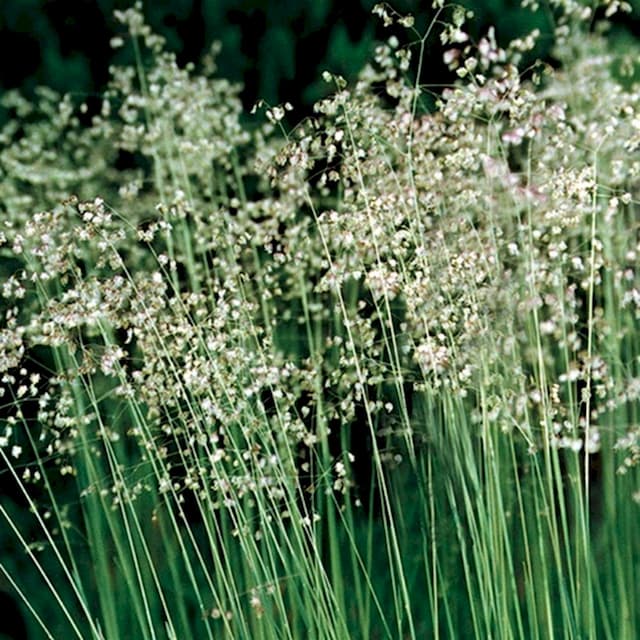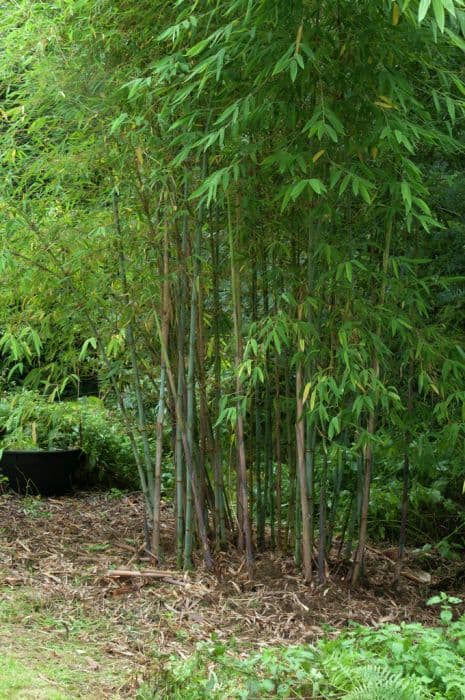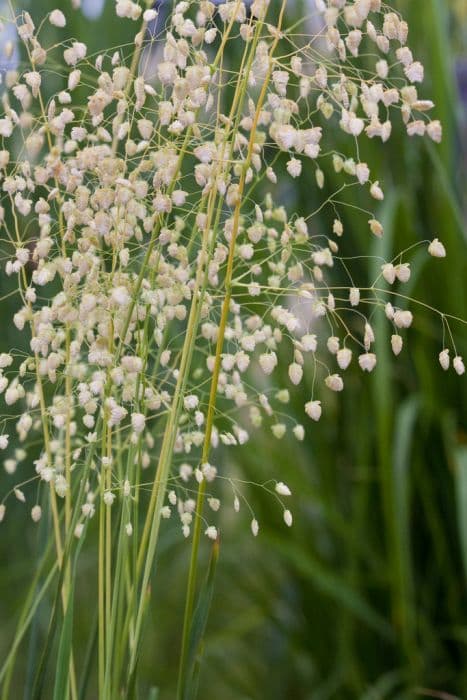Korean Feather Reed Grass Calamagrostis brachytricha

ABOUT
The plant, commonly known as Korean feather reed grass, exhibits a graceful, fountain-like form with a lush, tufted growth habit. Its appearance is marked by slender, arching leaves that are a fresh green color, creating a dense and textured backdrop. During the late summer to early fall, this plant produces feathery flower panicles. These blooms are initially a purplish-pink color, which eventually matures to a soft, silvery white, imparting an ethereal quality as they catch the light and move with the breeze. As the seasons progress, the foliage of Korean feather reed grass transitions into a golden hue, adding a warm, autumnal aspect to its presence. The plant is noted for its overall elegant and refined look, making it a popular choice for ornamental use in gardens and landscapes.
About this plant
 Names
NamesFamily
Poaceae
Synonyms
Korean Feather Reed Grass, Diamond Grass, Foxtail Reed Grass
Common names
Achnatherum brachytrichum, Calamagrostis arundinacea subsp. brachytricha, Calamagrostis epigeios var. brachytricha.
 Toxicity
ToxicityTo humans
The Korean feather reed grass is not commonly known to be toxic to humans. There are no well-documented symptoms or consequences of poisoning from ingesting any part of the Korean feather reed grass, as it is generally considered a non-toxic plant for human interactions.
To pets
The Korean feather reed grass is not known to be toxic to pets. It does not typically present any symptoms of poisoning if ingested by animals such as dogs or cats, making it a relatively safe plant in gardens and homes where pets are present.
 Characteristics
CharacteristicsLife cycle
Perennials
Foliage type
Deciduous
Color of leaves
Green
Flower color
Pink
Height
3-4 feet (0.9-1.2 meters)
Spread
2-3 feet (0.6-0.9 meters)
Plant type
Grass
Hardiness zones
4-9
Native area
Asia
Benefits
 General Benefits
General Benefits- Ornamental value: Calamagrostis brachytricha, commonly known as Korean feather reed grass, provides a distinct aesthetic appeal to gardens and landscapes with its feathery plumes and attractive foliage.
- Erosion control: Its extensive root system helps stabilize soil and control erosion, particularly on slopes and banks.
- Low maintenance: It is generally a low-maintenance plant that requires minimal care once established, making it suitable for many garden settings.
- Drought tolerance: Korean feather reed grass is relatively drought-tolerant once established, reducing the need for frequent watering.
- Wildlife habitat: The plant creates a habitat for wildlife, offering shelter and food sources for birds and insects.
- Seasonal interest: Provides year-round interest with its changing foliage colors and persistent flower plumes well into the winter months.
- Tolerant of poor soils: Can thrive in a variety of soil conditions, including poor soils, where other plants might struggle to survive.
 Medical Properties
Medical PropertiesThis plant is not used for medical purposes.
 Air-purifying Qualities
Air-purifying QualitiesThis plant is not specifically known for air purifying qualities.
 Other Uses
Other Uses- Calamagrostis brachytricha, also known as Korean feather reed grass, can be used in basketry, with its long stems being suitable for weaving into various patterns and styles.
- The dense clumps formed by the Korean feather reed grass can provide a natural habitat and shelter for small wildlife and beneficial insects in a garden setting.
- Its sturdy stems can be utilized in the construction of small decorative fences or garden borders to add a rustic aesthetic to landscaping projects.
- Korean feather reed grass's straw can serve as a natural mulch for gardens, helping to retain moisture and suppress weeds while adding nutrients to the soil as it decomposes.
- The seed heads of the grass can be collected and used in dried floral arrangements, providing texture and visual interest.
- The plant's strong vertical growth habit can be used by landscape designers to create focal points or to frame views within a garden or park.
- Its graceful movement in the wind can be harnessed in soundscapes, where the rustling leaves contribute a soothing auditory element to a garden space.
- Dried stems can be used in crafting, such as in the creation of eco-friendly pens or small home décor items.
- Because of its adaptability to various soils, Korean feather reed grass can be used in erosion control projects to stabilize soil in at-risk areas.
- Due to its trend in natural landscaping, the plant's aesthetic is often incorporated into nature-inspired design elements, such as printed textiles and wallpaper patterns.
Interesting Facts
 Feng Shui
Feng ShuiThe Korean Feather Reed Grass is not used in Feng Shui practice.
 Zodiac Sign Compitability
Zodiac Sign CompitabilityThe Korean Feather Reed Grass is not used in astrology practice.
 Plant Symbolism
Plant Symbolism- Resilience – Calamagrostis brachytricha, commonly known as Korean feather reed grass, is known for its ability to thrive in a variety of conditions, symbolizing the resilience and adaptability in life.
- Gracefulness – This plant sways gracefully in the breeze, which can be seen as a representation of elegance and poise.
- Ease – The ease with which this grass blends into natural landscapes symbolizes harmony with the environment and going with the flow.
- Transition – The changing appearance of Korean feather reed grass throughout the seasons reflects the concept of transition and change in life.
 Water
WaterKorean feather reed grass prefers consistent moisture but is relatively drought-tolerate once established. During the first growing season, it is essential to keep the soil consistently moist to encourage a deep and extensive root system; watering once or twice a week should suffice, depending on the climate and soil conditions. Use about 1 to 1.5 gallons of water per plant for each watering session, ensuring the water penetrates deeply into the soil. After the first year, Korean feather reed grass can tolerate less frequent watering, but during prolonged dry spells or extreme heat, increase watering to maintain soil moisture.
 Light
LightKorean feather reed grass thrives in full sun to partial shade conditions. It performs best when it receives at least four to six hours of direct sunlight daily. This grass can adapt to various lighting conditions, but its growth might be less vigorous in too much shade. Choose a spot in your garden that receives ample sunshine for optimal growth and flowering of Korean feather reed grass.
 Temperature
TemperatureKorean feather reed grass is hardy and can tolerate a broad range of temperatures, with an ideal growing range between 50°F and 75°F. It can survive minimum temperatures down to -20°F making it suitable for many temperate climates. During extreme heat above 90°F or sudden frost, take steps to protect the plant if necessary, although it is generally quite resilient to fluctuations in temperature.
 Pruning
PruningPruning Korean feather reed grass involves cutting back the plant in late winter or early spring before new growth begins. This promotes healthy growth and prevents the grass from looking untidy. Cut the foliage back to about 4 inches from the ground using sharp shears. Pruning once a year is generally sufficient, and the best time for this is when the threat of heavy frost has passed but before new shoots appear.
 Cleaning
CleaningAs needed
 Soil
SoilThe Korean Feather Reed Grass prefers a soil mix that holds moisture yet drains well. A mixture of loamy soil amended with peat or compost is ideal. Maintain soil pH between 5.5 and 7.0 for optimal growth.
 Repotting
RepottingKorean Feather Reed Grass, being a perennial grass, typically does not require frequent repotting. Repot every 2-3 years to refresh the soil or divide the clumps for propagation.
 Humidity & Misting
Humidity & MistingKorean Feather Reed Grass thrives in average outdoor humidity. It does not require any special humidity conditions when planted in its natural outdoor environment.
 Suitable locations
Suitable locationsIndoor
Ensure bright light, adequate water, and pot with drainage.
Outdoor
Full sun to partial shade, well-draining soil, water regularly.
Hardiness zone
4-9 USDA
 Life cycle
Life cycleCalamagrostis brachytricha, also known as Korean Feather Reed Grass, begins its life cycle as a seed, which germinates in moist soil during the spring. As seedlings establish, they form dense tufts of foliage, with narrow, arching leaves that grow actively during the warm seasons. This perennial grass reaches maturity and forms distinctive, feathery plumes that are silvery-pink to purple in color by late summer to early fall, which are its inflorescences or flowering parts. Following pollination, which is typically carried out by the wind, the plant produces small grains that serve as seeds. These seeds disperse in the fall or winter, often with the help of wind or animals, to start new plants in surrounding areas. During the winter, the above-ground parts of Korean Feather Reed Grass die back, but the plant survives with its underground rhizomes, ready to regrow in the following spring.
 Propogation
PropogationPropogation time
Late spring
Calamagrostis brachytricha, commonly known as Korean feather reed grass, is most effectively propagated by division. The ideal time to propagate this ornamental grass is in the spring, just as the plant begins its growth cycle. To propagate by division, a mature clump should be dug up and separated into smaller sections, ensuring that each section has a healthy portion of roots attached. These sections are then planted in well-draining soil, at the same depth they were originally growing. Water them thoroughly after planting to help establish the roots. This method allows the plant to recover from the division process throughout the growing season, resulting in a robust display by fall.









